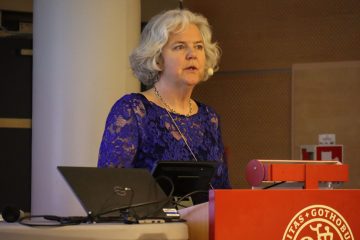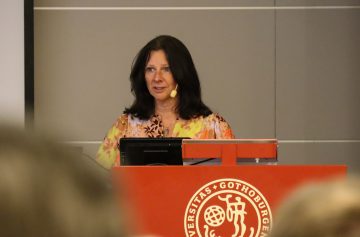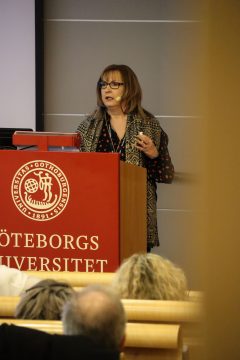SEMINAR. With the 3Rs in focus, the University of Gothenburg has many good examples of how animal welfare is continuously improved. At the 3R seminar, which is arranged annually by the university’s Animal Welfare Body, both cutting-edge research and methods for reducing the use of animals were presented. Charbel Sader, Communications Officer at Core Facilities, provides this report from the seminar.
Replace: Malin Celander on replacing animals with cell lines

Malin Celander, professor of zoological physiology, started off the seminar trio by presenting her research, in which replacing animal models with other methods plays a central role.
In 2022, Malin received a grant from the organization Forska utan djurförsök, which distributed a total of SEK 4.8 million to 15 projects in Sweden. The goal of Malin’s project is to develop animal-free in vitro tests for future OECD chemical risk assessments which can replace tests on fish.
The project uses three cell lines from different fish species, as well as tissues from zebrafish embryos, rainbow gills and guppy livers.
“It is a big challenge to translate results from cells to an entire organism, but for the specific biomarkers we study, we can see from a physiological perspective that cells can actually represent an entire fish. However, a critical approach and caution in drawing conclusions is very important. For example, primary tests can be carried out in cells after which selected results can be verified in experiments with animals, which means that many trials using animals would be replaced in the first step,” Malin said.
Reduce: Anne Edenro on reducing the number of animals in research

As one of few places in Sweden, Experimental Biomedicine (EBM) is now offering cryopreservation as a way to reduce the number of animals that are bred to maintain strains, but without being used in research. In cryopreservation, eggs or sperm are frozen and kept for later usage. The procedure is carried out by EBM’s partners, and the method is used for mouse strains that are not to be used for research in the near future. Anne Edenro, head of unit at EBM, talked about how EBM as a research infrastructure is working proactively with reducing the number of animals.
“We received signals from our animal technicians that they want to see a change in the breeding management, and we are now advising all researchers at EBM to use cryopreservation. In dialogue with research leaders, we are also working on a policy and recommendations for breeding, with the overall goal of reducing the number of animals,” Anne said.
As a result, breeding for the maintenance of mouse strains has been reduced by 80 percent at EBM, which means fewer animals, lower costs and reduced use of resources.
“The next step is to continue to increase the knowledge among researchers, and we also hope that our work will inspire other facilities in Sweden.”
Refine: Lynne Sneddon on pain relief in research studies

During the third and final talk of the day, Lynne Sneddon who is senior lecturer at the Department of Biological and Environmental Sciences, focused on refinement. Lynne is the first to characterise nociceptors that detect painful stimuli on the head of a fish. In her research, she aims to understand the mechanisms underpinning animal behaviour by employing techniques in genomics, molecular biology, physiology and neurobiology.
“Refining experiments will mean both alleviating pain in animals, and also improving research results. When studying animals in pain, you could be recording the response to the pain rather than finding answers to the treatment you are actually investigating. Next to improved results we also have a moral and ethical duty to these animals to safeguard their welfare, we must follow legislation, and also keep a high confidence from the public for our research.” Lynne said.
By developing AI cameras with a unique software, Lynne and her team has been able to visualize the movement patterns of healthy and of pain-afflicted zebrafish. Her studies have resulted among other things in revised rules in the UK, where certain procedures that previously were considered mild are now considered moderate and therefore requires the use of pain-relieving drugs.
Changes within the Animal Welfare Body (AWB)

This year’s 3R seminar was also the last one where Michael Axelsson is the organizer as he retires this year. Michael is professor at the Department of Biological and Environmental Science.
“Many thanks Michael for your presence in our AWB, great knowledge in research questions, and solid commitment especially to the 3R work at the University of Gothenburg,” the dean of Sahlgrenska academy Agneta Holmäng said as she was thanking Michael for his work.
Sara Barr, who is the administrator for DO, continues in her role and is in charge of next year’s 3R meeting.
Both the Swedish 3R-center and the Swedish Board for Agriculture participated in the meeting and talked about ongoing projects and the new e-service for ethical applications.
The 3R seminar is aimed for all staff working with animal testing, and participants receive a CPD certificate after the seminar.
BY: CHARBEL SADER











